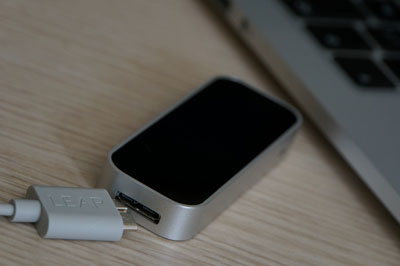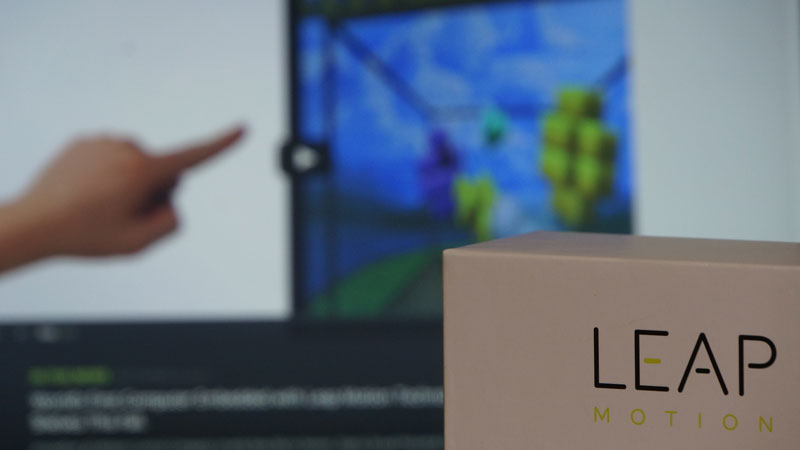The Leap Motion made its internet debut in May 2012, and generated quite a lot of buzz. Many were excited to see this “Kinect for computers” – referring to Microsoft’s motion-sensing accessory for the Xbox 360 – but some remained reserved, given how the Kinect itself wasn’t as responsive. However, Leap started shipping the Leap Motion earlier this year, and proved that its product was as good as the demos it showed at launch. There was real reason to get excited about the Leap Motion and a new world of 3D gestures in desktop computing.
Two weeks ago it was confirmed to htxt.africa that the Leap Motion would go on sale locally, exclusively available through Incredible Connection. And now that we’ve played with one for two weeks, we have a verdict on whether you should rush out and buy one, or hang onto your cash.
Design
- An aluminium band with a black glass surface is all you see when looking at the Leap itself. Sure, there’s a port for a micro USB 3.0 cable, but that’s a necessary evil. Everything else is pure simplicity. Flip it over and you’ll see a rubberised bottom, all the better to stay put on a desk, and that’s imprinted with the Leap Motion logo. The Leap Motion is incredibly small for what it is. It’s about the size of a large USB stick – a size that belies the complexity of its inner workings.
- The best way to describe design of the device is to say that it is Apple-like. It doesn’t need to do anything more than sit on a desk, but Leap still did a great job to make sure that this isn’t another ugly wart on a modern desktop, which may or may not have a good-looking laptop, mouse, or other accessories.
- While it’s not wireless – more on that in performance – Leap does provide two branded USB cables. A shorter 50cm cable for those who need to use it with their laptops, and a longer 50cm cable for desktops. A small, but nice, touch.
Performance

Anybody who’s used an Xbox Kinect will know how that system – even when used with a computer – has a slight processing delay. Move now, and your actions are mirrored on screen a few hundred milliseconds later. Granted, the Kinect is dealing with a lot of data, including visual cameras, and is set up for a full body – but it’s how most people will first be introduced to motion detection on a large scale.
In contrast, the Leap Motion, by virtue of it being designed specifically for detecting hands, is instantaneous. It has an accuracy level of 0.01mm, something that’s believable when you use the calibration tools to see how it depicts virtual skeletons of your hands. Tracking is extremely accurate, and the detection range is fairly generous – as well as adjustable. By default the Leap Motion will detect all both hands an all fingers as soon as they enter within 40cm or so, looking forward. The vertical detection zone extends for nearly a metre. However, detection is more accurate when closer to the sensor. When on the edges of the detection zone, it’s not nearly as reliable, and applications can produce strange results. It also helps if you don’t have any fluorescent lamps nearby – a known issue for any motion tech using infrared. And always keep the lens clean. During testing, the Leap once complained that there was a smudge on the glass when there wasn’t. Unplugging and reconnecting it resolved the issue.
The tech that makes this possible is an array of infrared LEDs that map out your hands and fingers in 3D, similar to the technique used by the Kinect, just on a smaller scale. While the Kinect’s two camera sensors are further apart, to detect depth in a larger area, the Leap gets away with a few more sensors in a narrower area. The speed of input is partly down to the fact that modern computers are so much faster than the Xbox, and processing can be offloaded to a fast Intel processor much easier than it could happen with older hardware. As a result, the minimum requirements for the Leap Motion are relatively high – a modern Core i3 processor, or faster, and at least 2GB of RAM.
Software
I t’s all great having powerful hardware that works as advertised, but supporting software plays the most important role. Without good software, the Leap Motion is just a small box that lights up.
t’s all great having powerful hardware that works as advertised, but supporting software plays the most important role. Without good software, the Leap Motion is just a small box that lights up.
To that end, Leap has created the cleverly-named Airspace app store. This is accessed by opening the Leap control centre, which loads the Airspace store in a web browser. Despite being web-based the storefront is very intuitive to browse and search. Since the Leap works on both Windows and Mac OS X, apps are marked as such. Apps available for both platforms have a Windows and Apple icon, and so on. There’s no need to download separate versions, as auto-detection code will take care of that for you. There’s also a decent selection of free apps for you to get started with.
The real issue, though, is the selection of applications. It’s not the number of apps – the Airspace store is only a few months old, after all, and will grow over time – but the usefulness of what’s on offer.
As expected, there are a handful of games. These are bespoke creations, too, rather than existing titles that have been given Leap Motion integration. They’re not AAA titles, but the production values are good and the novel implementation of the Leap’s capabilities push them past gimmicky.
There are also a number of applications that let you take control of your computer with the Leap. That is to say, these replace the mouse and let you use your finger as a mouse pointer. Accuracy here is down to the application’s use of the Leap’s data as well as how you have the device set up. It’s sensitive to fluorescent lamps, which cause glitchy detection (and you end up clicking on something you didn’t mean to). That said, while these work well it’s probably not the most ideal way to use a computer. Your arms get tired, and even with the detailed data from the Leap it’s impossible to beat a mouse for speed and accuracy when it comes to clicking on buttons. Though there’s an app called BetterTouchTool, which lets you create air gestures for your the Leap. Rather than replacing your mouse it lets the leap be used when it’s best, while still keeping a mouse in play – this is a better solution for Leap-assisted control.
The bespoke applications are where it shines, though. Apps that have 3D models that need manipulating, or use air gestures for navigation. But these are standalone applications and some can be very pricey. The free apps give a taste of what it’s like, but there’s no way to get a demo of the expensive apps.
Conclusion
Perhaps apps aren’t the future of the Leap, though. A few of the free apps in Airspace are actually websites that use the Leap Motion API. One example was a virtual theremin that ran in a web browser. If Leap integration were standardised and featured everywhere, rather than having standalone uses, buying one would be easier to swallow. As it stands now, it’s a case of the Leap being an accessory for specific bits of software.
And what it really needs is to augment and enhance existing platforms.
Design 5/5
Performance 4/5
Value for Money 3/5
Interface 4/5
Overall 4/5
Detail
Price: R1 299
Contact: Thanks to Aphelion for supplying this review unit, ahead of release.


